Jaewoo Kang
Does Time Have Its Place? Temporal Heads: Where Language Models Recall Time-specific Information
Feb 20, 2025



Abstract:While the ability of language models to elicit facts has been widely investigated, how they handle temporally changing facts remains underexplored. We discover Temporal Heads, specific attention heads primarily responsible for processing temporal knowledge through circuit analysis. We confirm that these heads are present across multiple models, though their specific locations may vary, and their responses differ depending on the type of knowledge and its corresponding years. Disabling these heads degrades the model's ability to recall time-specific knowledge while maintaining its general capabilities without compromising time-invariant and question-answering performances. Moreover, the heads are activated not only numeric conditions ("In 2004") but also textual aliases ("In the year ..."), indicating that they encode a temporal dimension beyond simple numerical representation. Furthermore, we expand the potential of our findings by demonstrating how temporal knowledge can be edited by adjusting the values of these heads.
GPO-VAE: Modeling Explainable Gene Perturbation Responses utilizing GRN-Aligned Parameter Optimization
Jan 31, 2025Abstract:Motivation: Predicting cellular responses to genetic perturbations is essential for understanding biological systems and developing targeted therapeutic strategies. While variational autoencoders (VAEs) have shown promise in modeling perturbation responses, their limited explainability poses a significant challenge, as the learned features often lack clear biological meaning. Nevertheless, model explainability is one of the most important aspects in the realm of biological AI. One of the most effective ways to achieve explainability is incorporating the concept of gene regulatory networks (GRNs) in designing deep learning models such as VAEs. GRNs elicit the underlying causal relationships between genes and are capable of explaining the transcriptional responses caused by genetic perturbation treatments. Results: We propose GPO-VAE, an explainable VAE enhanced by GRN-aligned Parameter Optimization that explicitly models gene regulatory networks in the latent space. Our key approach is to optimize the learnable parameters related to latent perturbation effects towards GRN-aligned explainability. Experimental results on perturbation prediction show our model achieves state-of-the-art performance in predicting transcriptional responses across multiple benchmark datasets. Furthermore, additional results on evaluating the GRN inference task reveal our model's ability to generate meaningful GRNs compared to other methods. According to qualitative analysis, GPO-VAE posseses the ability to construct biologically explainable GRNs that align with experimentally validated regulatory pathways. GPO-VAE is available at https://github.com/dmis-lab/GPO-VAE
KU AIGEN ICL EDI@BC8 Track 3: Advancing Phenotype Named Entity Recognition and Normalization for Dysmorphology Physical Examination Reports
Jan 16, 2025Abstract:The objective of BioCreative8 Track 3 is to extract phenotypic key medical findings embedded within EHR texts and subsequently normalize these findings to their Human Phenotype Ontology (HPO) terms. However, the presence of diverse surface forms in phenotypic findings makes it challenging to accurately normalize them to the correct HPO terms. To address this challenge, we explored various models for named entity recognition and implemented data augmentation techniques such as synonym marginalization to enhance the normalization step. Our pipeline resulted in an exact extraction and normalization F1 score 2.6\% higher than the mean score of all submissions received in response to the challenge. Furthermore, in terms of the normalization F1 score, our approach surpassed the average performance by 1.9\%. These findings contribute to the advancement of automated medical data extraction and normalization techniques, showcasing potential pathways for future research and application in the biomedical domain.
Monet: Mixture of Monosemantic Experts for Transformers
Dec 05, 2024



Abstract:Understanding the internal computations of large language models (LLMs) is crucial for aligning them with human values and preventing undesirable behaviors like toxic content generation. However, mechanistic interpretability is hindered by polysemanticity -- where individual neurons respond to multiple, unrelated concepts. While Sparse Autoencoders (SAEs) have attempted to disentangle these features through sparse dictionary learning, they have compromised LLM performance due to reliance on post-hoc reconstruction loss. To address this issue, we introduce Mixture of Monosemantic Experts for Transformers (Monet) architecture, which incorporates sparse dictionary learning directly into end-to-end Mixture-of-Experts pretraining. Our novel expert decomposition method enables scaling the expert count to 262,144 per layer while total parameters scale proportionally to the square root of the number of experts. Our analyses demonstrate mutual exclusivity of knowledge across experts and showcase the parametric knowledge encapsulated within individual experts. Moreover, Monet allows knowledge manipulation over domains, languages, and toxicity mitigation without degrading general performance. Our pursuit of transparent LLMs highlights the potential of scaling expert counts to enhance} mechanistic interpretability and directly resect the internal knowledge to fundamentally adjust} model behavior. The source code and pretrained checkpoints are available at https://github.com/dmis-lab/Monet.
Culinary Class Wars: Evaluating LLMs using ASH in Cuisine Transfer Task
Nov 04, 2024

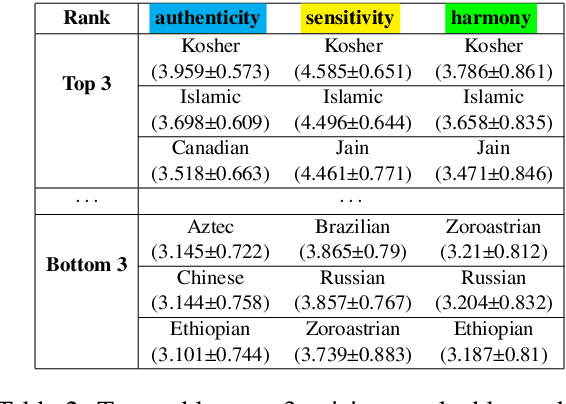
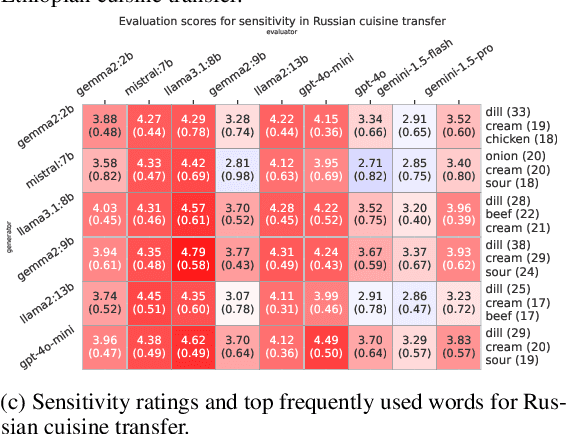
Abstract:The advent of Large Language Models (LLMs) have shown promise in various creative domains, including culinary arts. However, many LLMs still struggle to deliver the desired level of culinary creativity, especially when tasked with adapting recipes to meet specific cultural requirements. This study focuses on cuisine transfer-applying elements of one cuisine to another-to assess LLMs' culinary creativity. We employ a diverse set of LLMs to generate and evaluate culturally adapted recipes, comparing their evaluations against LLM and human judgments. We introduce the ASH (authenticity, sensitivity, harmony) benchmark to evaluate LLMs' recipe generation abilities in the cuisine transfer task, assessing their cultural accuracy and creativity in the culinary domain. Our findings reveal crucial insights into both generative and evaluative capabilities of LLMs in the culinary domain, highlighting strengths and limitations in understanding and applying cultural nuances in recipe creation. The code and dataset used in this project will be openly available in \url{http://github.com/dmis-lab/CulinaryASH}.
Rationale-Guided Retrieval Augmented Generation for Medical Question Answering
Nov 01, 2024



Abstract:Large language models (LLM) hold significant potential for applications in biomedicine, but they struggle with hallucinations and outdated knowledge. While retrieval-augmented generation (RAG) is generally employed to address these issues, it also has its own set of challenges: (1) LLMs are vulnerable to irrelevant or incorrect context, (2) medical queries are often not well-targeted for helpful information, and (3) retrievers are prone to bias toward the specific source corpus they were trained on. In this study, we present RAG$^2$ (RAtionale-Guided RAG), a new framework for enhancing the reliability of RAG in biomedical contexts. RAG$^2$ incorporates three key innovations: a small filtering model trained on perplexity-based labels of rationales, which selectively augments informative snippets of documents while filtering out distractors; LLM-generated rationales as queries to improve the utility of retrieved snippets; a structure designed to retrieve snippets evenly from a comprehensive set of four biomedical corpora, effectively mitigating retriever bias. Our experiments demonstrate that RAG$^2$ improves the state-of-the-art LLMs of varying sizes, with improvements of up to 6.1\%, and it outperforms the previous best medical RAG model by up to 5.6\% across three medical question-answering benchmarks. Our code is available at https://github.com/dmis-lab/RAG2.
TurboHopp: Accelerated Molecule Scaffold Hopping with Consistency Models
Oct 28, 2024



Abstract:Navigating the vast chemical space of druggable compounds is a formidable challenge in drug discovery, where generative models are increasingly employed to identify viable candidates. Conditional 3D structure-based drug design (3D-SBDD) models, which take into account complex three-dimensional interactions and molecular geometries, are particularly promising. Scaffold hopping is an efficient strategy that facilitates the identification of similar active compounds by strategically modifying the core structure of molecules, effectively narrowing the wide chemical space and enhancing the discovery of drug-like products. However, the practical application of 3D-SBDD generative models is hampered by their slow processing speeds. To address this bottleneck, we introduce TurboHopp, an accelerated pocket-conditioned 3D scaffold hopping model that merges the strategic effectiveness of traditional scaffold hopping with rapid generation capabilities of consistency models. This synergy not only enhances efficiency but also significantly boosts generation speeds, achieving up to 30 times faster inference speed as well as superior generation quality compared to existing diffusion-based models, establishing TurboHopp as a powerful tool in drug discovery. Supported by faster inference speed, we further optimize our model, using Reinforcement Learning for Consistency Models (RLCM), to output desirable molecules. We demonstrate the broad applicability of TurboHopp across multiple drug discovery scenarios, underscoring its potential in diverse molecular settings.
ETHIC: Evaluating Large Language Models on Long-Context Tasks with High Information Coverage
Oct 22, 2024



Abstract:Recent advancements in large language models (LLM) capable of processing extremely long texts highlight the need for a dedicated evaluation benchmark to assess their long-context capabilities. However, existing methods, like the needle-in-a-haystack test, do not effectively assess whether these models fully utilize contextual information, raising concerns about the reliability of current evaluation techniques. To thoroughly examine the effectiveness of existing benchmarks, we introduce a new metric called information coverage (IC), which quantifies the proportion of the input context necessary for answering queries. Our findings indicate that current benchmarks exhibit low IC; although the input context may be extensive, the actual usable context is often limited. To address this, we present ETHIC, a novel benchmark designed to assess LLMs' ability to leverage the entire context. Our benchmark comprises 2,648 test instances spanning four long-context tasks with high IC scores in the domains of books, debates, medicine, and law. Our evaluations reveal significant performance drops in contemporary LLMs, highlighting a critical challenge in managing long contexts. Our benchmark is available at https://github.com/dmis-lab/ETHIC.
ChroKnowledge: Unveiling Chronological Knowledge of Language Models in Multiple Domains
Oct 13, 2024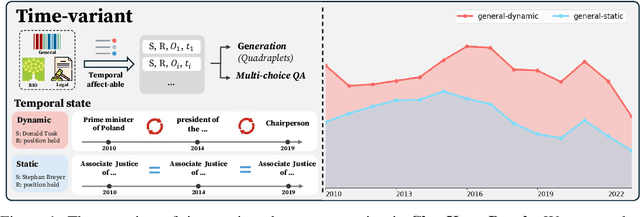


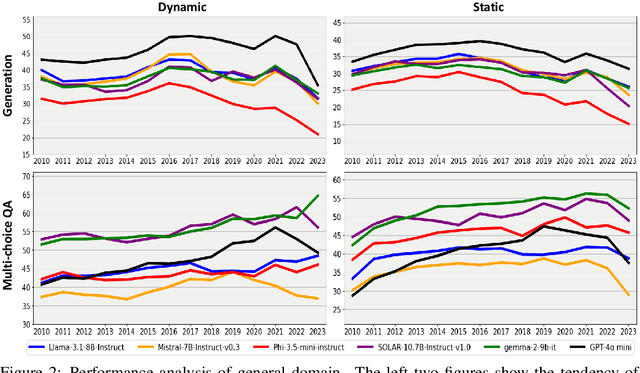
Abstract:Large language models (LLMs) have significantly impacted many aspects of our lives. However, assessing and ensuring their chronological knowledge remains challenging. Existing approaches fall short in addressing the accumulative nature of knowledge, often relying on a single time stamp. To overcome this, we introduce ChroKnowBench, a benchmark dataset designed to evaluate chronologically accumulated knowledge across three key aspects: multiple domains, time dependency, temporal state. Our benchmark distinguishes between knowledge that evolves (e.g., scientific discoveries, amended laws) and knowledge that remain constant (e.g., mathematical truths, commonsense facts). Building on this benchmark, we present ChroKnowledge (Chronological Categorization of Knowledge), a novel sampling-based framework for evaluating and updating LLMs' non-parametric chronological knowledge. Our evaluation shows: (1) The ability of eliciting temporal knowledge varies depending on the data format that model was trained on. (2) LLMs partially recall knowledge or show a cut-off at temporal boundaries rather than recalling all aspects of knowledge correctly. Thus, we apply our ChroKnowPrompt, an in-depth prompting to elicit chronological knowledge by traversing step-by-step through the surrounding time spans. We observe that our framework successfully updates the overall knowledge across the entire timeline in both the biomedical domain (+11.9%) and the general domain (+2.8%), demonstrating its effectiveness in refining temporal knowledge. This non-parametric approach also enables knowledge updates not only in open-source models but also in proprietary LLMs, ensuring comprehensive applicability across model types. We perform a comprehensive analysis based on temporal characteristics of ChroKnowPrompt and validate the potential of various models to elicit intrinsic temporal knowledge through our method.
CRADLE-VAE: Enhancing Single-Cell Gene Perturbation Modeling with Counterfactual Reasoning-based Artifact Disentanglement
Sep 10, 2024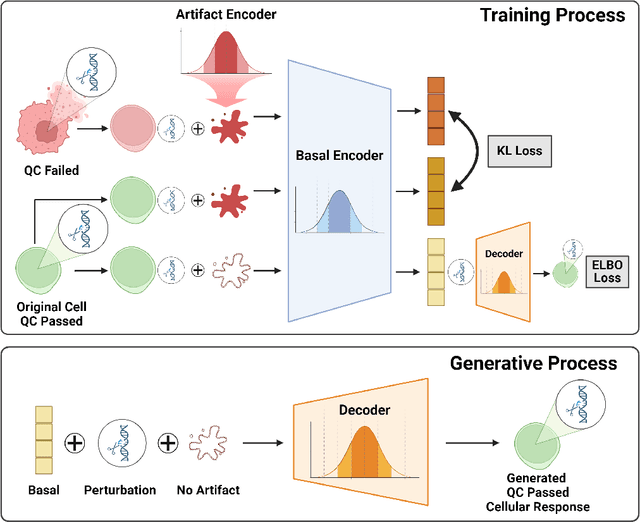

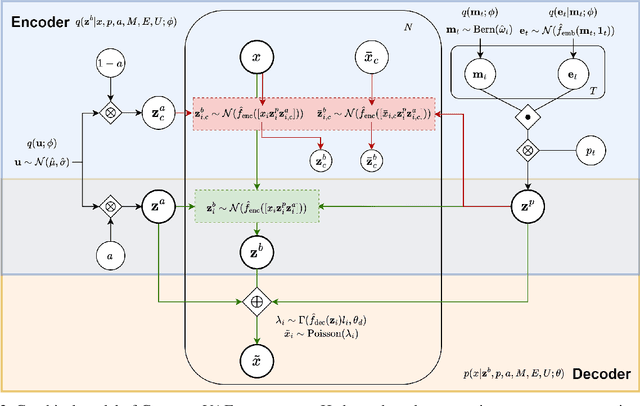
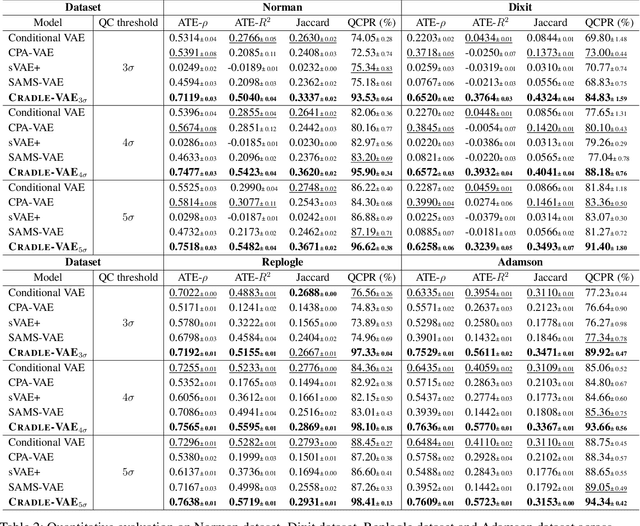
Abstract:Predicting cellular responses to various perturbations is a critical focus in drug discovery and personalized therapeutics, with deep learning models playing a significant role in this endeavor. Single-cell datasets contain technical artifacts that may hinder the predictability of such models, which poses quality control issues highly regarded in this area. To address this, we propose CRADLE-VAE, a causal generative framework tailored for single-cell gene perturbation modeling, enhanced with counterfactual reasoning-based artifact disentanglement. Throughout training, CRADLE-VAE models the underlying latent distribution of technical artifacts and perturbation effects present in single-cell datasets. It employs counterfactual reasoning to effectively disentangle such artifacts by modulating the latent basal spaces and learns robust features for generating cellular response data with improved quality. Experimental results demonstrate that this approach improves not only treatment effect estimation performance but also generative quality as well. The CRADLE-VAE codebase is publicly available at https://github.com/dmis-lab/CRADLE-VAE.
 Add to Chrome
Add to Chrome Add to Firefox
Add to Firefox Add to Edge
Add to Edge